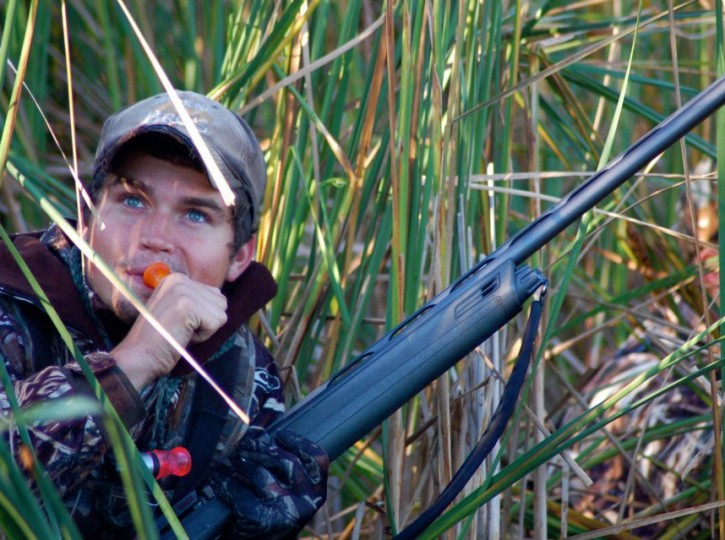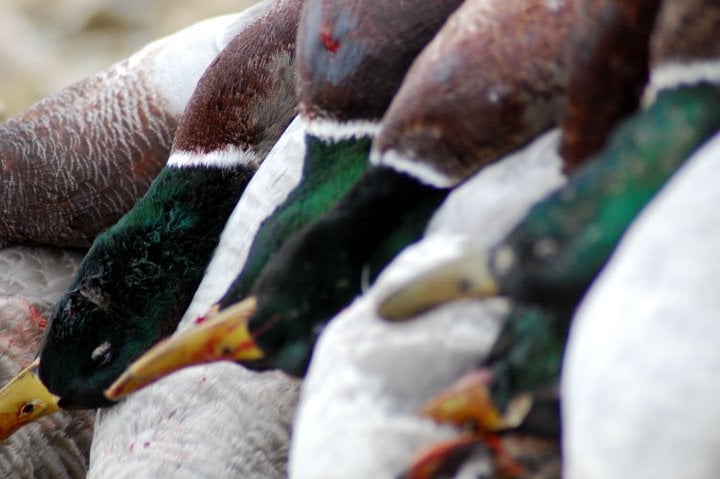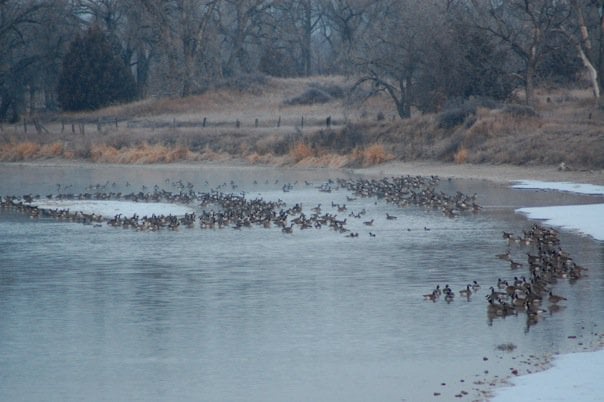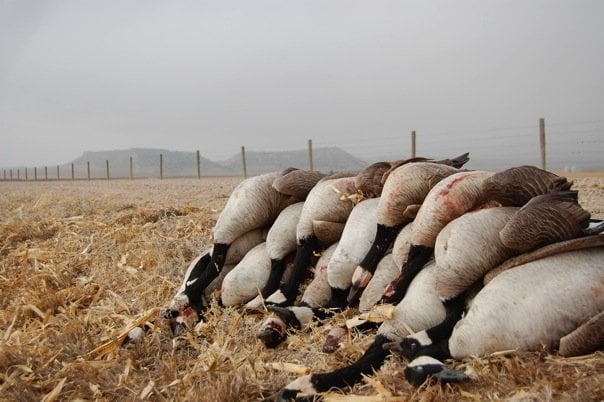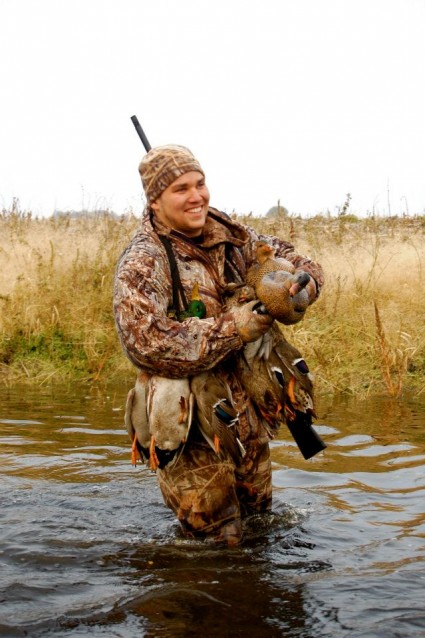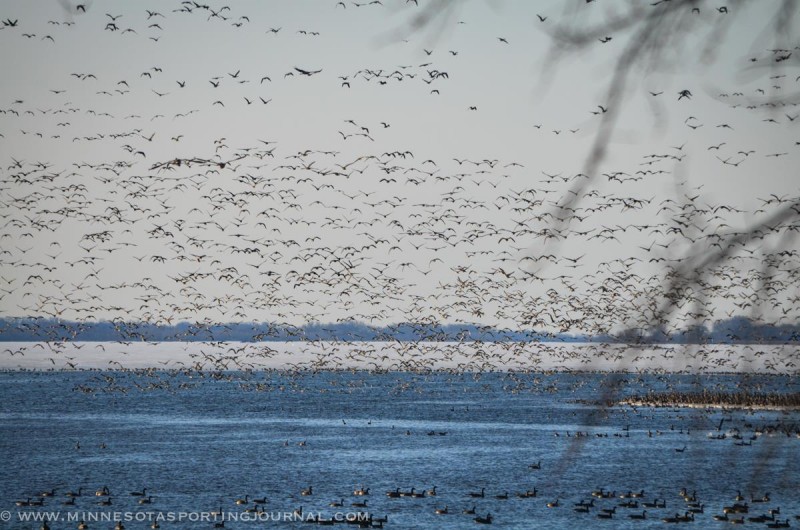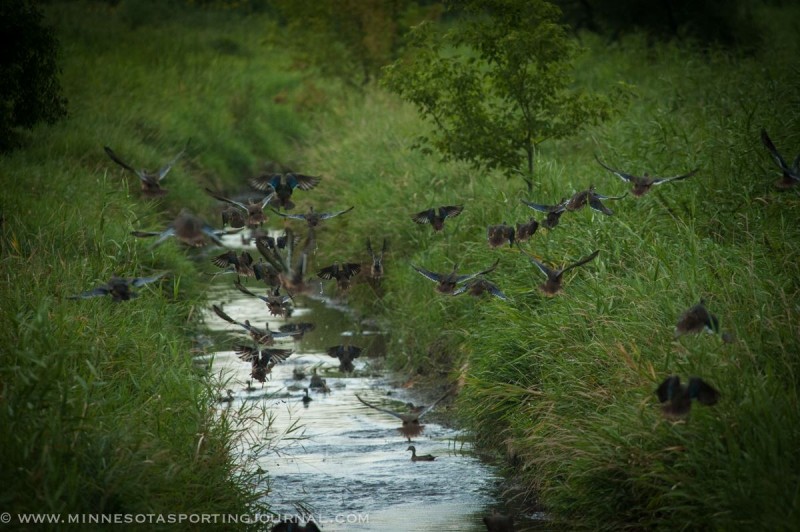Drive to Waterfowl Destinations
- Kulm & Jamestown, North Dakota
- Bay of Green Bay, Wisconsin
- Lingle, Wyoming
- Saskatchewan
- Leech Lake & Lake Winnie
- Lac Qui Parle Refuge, Watson Minnesota
- Rum River near Milaca Minnesota
North Dakota
North Dakota is my number one drive to destination, and there are no secrets. It’s hands down the best state to pursue waterfowl in the upper half of the United States. Besides being located in the prairie pothole region, and having an abundance of waterfowl, the land access regulations are what shoots North Dakota to the top of our list. As the rules state, you are able to hunt private land without landowner permission as long as the land isn’t posted. It’s happened time after time where you find a picturesque field loaded with thousands of Mallards and can’t find the landowner information. The beauty of it is often times in North Dakota, the land won’t be posted, and those mallards are yours!
As a general rule of thumb, where you find water you’ll find duck and geese. There are certain areas I’ve hunted with easy access to land and plenty of birds. The first is the Edgely/Kulm area located two hours from Fargo, as it is right on the edge of the Pothole region and farm country. This gives birds easy access to water with ample opportunity for field hunting.
If you aren’t looking to go quite that far west, Jamestown, located a couple hours into North Dakota on I-94 is a hotspot. While it does receive more pressure, Arrowhead National Wildlife Refuge and Jamestown Reservoir provide a large bodies of water where big flocks of birds can safely find refuge. If an area is posted, landowners are generally willing to grant access as long as you are respectful of their land. Cleaning up empty hulls, closing gates behind you, and not driving in wet fields are a easy steps to ensure you’ll be invited back.
Bay of Green Bay
This is number one on my bucket list, and for good reason! It’s one of the only spots in the Midwest where you are able to target ocean ducks such as Scoter and Long Tails. All the way from the city of Green Bay, through Sturgeon Bay up to Washington Harbor is loaded with diving ducks.
Not only is it a great ocean duck location, it’s known as a staging area for thousands of bluebills, Goldeneyes, Buffleheads, and Redheads. October marks the arrival of the Redheads followed by Bluebills, and come early November the Goldeneyes show up in throngs. The offshore sea duck hunting really heats up in in the beginning of November and runs through the end of the season in early November.
Hunting with layout boats will offer the best opportunity at tying into a pile of diving ducks. If you are short a layout boat, head out to one of the islands or points up and down the shoreline and run a line of decoys out from the point. Coupled with layout blinds, and it’s going to be the last thing the never saw.
Be aware the seas can get a little rough, so you won’t want to tackle it in a small rig. A sea worthy boat of 18 foot or better will be adequate for the job.
Wyoming
Offering one of the best late season opportunities, you’ll be able to hunt ducks and geese through January into February. Located in eastern Wyoming, the Wheatland and Torrington areas are home to numerous reservoirs and river where ducks and geese pile in by the thousands. While obtaining permission on fields in the area can be daunting, there are options available along with hunting certain sections of the rivers themselves.
Located 11 hours from Minneapolis-St. Paul you’re able to scratch the waterfowl itch long after other seasons have been closed.
Be sure to obtain a copy of the regulations, and access the Office of State Lands & Investments State Land Access Maps online. The warden in the area is no doubt a stickler, and has been accused of being over zealous so be sure to know the local game regulations before you head out.
If you’re planning on goose hunting on the fields, a stout collection of decoys will be a must. Thousands of birds leave the reservoirs each morning and without a spread of 8-15 dozen decoys, the likelihood of success is limited. Geese migrate down from higher elevations to winter in the area and often times the closer to season’s end the better when looking to tie into a pile of geese.
Duck hunting on the rivers is a different story. Throw a couple of bags of decoys, and waders in the back of the truck and you will have a formidable spread. Remember Wyoming is different from states such as Minnesota where the land under the water is actually private, unlike the public waters of Minnesota. This means even though you’re still on the river, you have to find public land to walk or even drop anchor upon. The duck hunting season closes around the 3rd week in January, and the month of December and January are some of the best.
High Plains Wingshooters in Torrington Wyoming provides up to date reports on their website and Facebook page, and are a quality source of migration information when planning a trip to the area.
Saskatchewan
Saskatchewan is our only international destination on the list, but the long hours of windshield time is well worth it. It is described by many as “simply the best”, liberal limits, easy land access and thousands upon thousands of eager fowl.
The next reason to go, the season opens around the first of September most years, offering the opportunity to get on some early season ducks, snows and Canadas.
Often the problem of where to go comes to mind. After all Saskatchewan is a gigantic territory but the good news is, almost the entire range is considered the duck factory. Water conditions can play a huge part in finding an area. If it’s dry, then you can bet there won’t be many ducks in the area. Southwest Saskatchewan can offer some of the most fantastic Speck hunting of your life while the northern reaches from Quill Lake up to Tobin Lake offer fantastic duck, Canada and Snow hunting.
Land can often be obtained with the shake of a hand, and a few minutes of conversation. Whether you are looking to bring a entire spread, or sticking to small pothole hunts, there is something for everybody.
Filling the decoy trailer with 7-12 dozen fullbody honkers with 500-1000 snow good socks, 5 dozen mallard floaters, 2 dozen full body mallards, and as many spinning wing decoys as possible will leave you with the perfect set up for tromping around the prairies of Canada.
Canadian Customs is something you will have to deal with when traveling into Canada from the United States. With a little research online, the process becomes crystal clear. A firearms declaration form, and a few other signatures will get you what you need.
Head to the Royal Canadian Mounted Police website under the Canadian Firearms Program and all the information will be at your fingertips.
Lake Winnie and Leech Lake
Located within easy driving distance of the Twin Cities, it’s an area more associated with trophy Walleye and Muskies this time of year than with ducks. Don’t let it’s lack of a reputation fool you, within the area duck hunting community both rank near the top.
The migration diving ducks through this area is stellar, and whether you’re looking to target Goldeneye, Bluebills, Ring-bills or many other diver species, you’ve found the right place.
The time to be on these lakes is November, and the colder the better. As other smaller lakes begin to freeze up, both lakes especially Walker Bay on Leech Lake stay open attracting thousands of diving ducks to the area.
The great part about hunting Minnesota waters, unlike Wyoming, it’s all 100% public! This opens up endless hunting spots on both lakes.
If you decide to try Leech Lake, some of the go to spots are Ottertail Point, Stony Point, Pine Point, Pelican Island, Agency Bay Narrows, and the Federal Dam area. If you take a little time to do some glassing, it won’t be hard to find both rafts, and ducks on the wing. Get close to the area they are using and bingo.
Many people hunt from their fishing boat, parking it down the shoreline from where they hunt. The large lake and cold temperatures can make for some daunting conditions on some days, so you’ll want a reliable boat of at least 16’.
In terms of a decoy spread, you’ll want a gang rigged diver decoys for ease of set up. The more the merrier for late season divers, with anything form 5-10 dozen being good, but 10-13 dozen being ideal.
Lac Qui Parle
They don’t call it “the lake that speaks” for no reason. Over 100,000 staging geese call Lac Qui Parle home at a single time during peak migration times. This means enough geese to go around for everybody.
Located just over 2 hours from the Twin Cities, Lac Qui Parle is your best bet to get on a world-class goose hunt. The Montevideo area offers both public and private opportunities to get in front of geese.
Fields directly adjacent on the Lac Qui Parle Refuge can be very difficult to acquire landowner permission, as much of the land is leased or hunted on by other people. If you are unable to find a field or slough to hunt right off of the refuge, don’t worry!
You are able to hunt the refuge itself. Since 1976 hunters have had the opportunity to hunt geese by application process. This is no longer the case as hunters can show up at the Lac Qui Parle Headquarters at 6am between October 17th and November 30th, and can get in the daily drawing for a blind.
If a daily drawing doesn’t seem like your cup of tea and you can’t obtain land access, head north of the Appleton and east of the Ortonville area. Covered with potholes and pristine fields, this area also holds a lot of birds and you will get your fair share of migrators stopping down to check you out.
The Lac Qui Parle area does require more decoys to be competitive than other areas of the state. The birds see hundreds of decoy spreads, and if you’re not in the right field or do not have a large enough spread, the birds will simply forget about you!
This means an ideal spread of 10-15 dozen decoys to be competitive in the fields. If you are on the right field, as little as 5-dozen will do the trick.
Another option is to hire a guide. Watson Hunting Camp, located near the refuge offers first class guided goose hunts, with all equipment supplied, at an affordable price.
Rum River
This last one I hemmed and hawed over for a while before deciding to write about it. It’s one of the best areas I’ve found to consistently shoot limits of beautiful wood ducks during the early season.
Flowing south from Lake Mille Lacs all the way down to where it connects to the Mississippi River in Chaplain Park Minnesota, it’s a sleeper destination.
Here is the catch; all you need is a canoe, kayak, or small duck boat, and a buddy.
Leave one truck down south and head north with the other truck and you’ll be duck hunting in no time. Check out the DNR recreation compass to plan your trip in terms of distance, and entry and exit points.
Some great sections are from Milaca or just south of it down to Princeton. There are areas sprinkled along the stretch to enter and exit the river!
A productive stretch to the north is from Onamia to the walk in access by Four Brooks WMA. The floats mentioned before are all full day floats and would take you the majority of the day.
If you find a productive stretch of river, it should take you no more than 5 miles to take your birds!
Don’t be afraid to float the Rum all the way down near where it connects to Mississippi. It holds ducks down the entire river!
Floating the river a great way to extend your hunting time or if you don’t have the ambition to get out of bed, mid day hours are prime hours to float after woodies.
Hug the inside bank and come around tight corners and log jams slowly because it’s a prime hiding spot for ducks. You will also want to be as stealthy as possible so the birds hold in their position until you float within range.
